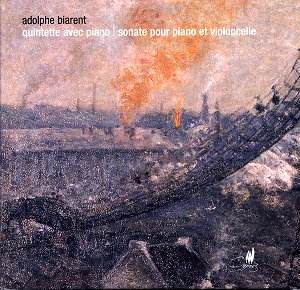A rich palette with infinite shades of colour. A
description from the Musée des Beaux-Arts de Charleroi of the
work of the painter Pierre Paulus (1881-1959), one of whose industrial
landscapes graces the cover and booklet of this ravishing and beautifully
produced disc. How appropriate then that Charleroi-born Adolphe Biarent,
himself a colourist of gifts, should have devoted himself to the promotion
of music in the town, to the establishment of symphony concerts there
and the nurturing of instrumental talent. Whilst it’s true that both
Ysaye and De Greef played some of his music Biarent’s profile remained
stubbornly local and his influence merely peripheral. He died of a cerebral
haemorrhage in February 1916 aged forty-four.
Stylistically he shares something of the Lekeu hothouse
and the expected influence of Franck remained almost unavoidably pervasive,
though utilised to Biarent’s ends, and diffused through awareness of
and consonance with Russian influences. Franck’s 1879 Quintet and the
Violin Sonata were nevertheless strongly influential and pervade both
works on this splendidly thoughtful disc. Biarent was himself a cellist
of standing and an experienced chamber player – he trained, amongst
many, Fernand Quinet, later to found the celebrated Pro Arte Quartet
– and clearly as accomplished a composer for smaller forces as he was
in the larger canvass. The B Minor Quintet was composed in 1913 and
slightly revised during May of the following year. In three movements
it’s notable for a compressed but intense sense of flux – chromatic,
harmonic – in which an initially dominant piano, fractious and controlling,
gradually responds to the pliant entreaties of the strings leading to
a reconciliation and sense of evolving balance. It is most impressive
to listen to the way in which Biarent introduces the first violin’s
songful openheartedness, underpinned as it is by the piano’s now rippling
figuration. Much here is sectional but the motivic conviction with which
Biarent handles his material is consistently convincing and if, at moments,
it’s hard not to think of the Franck Violin Sonata (at, for example
9’45 in the first movement) there is so much profusion of incident,
so agitated and adventurous, that one soon allows such moments to absorb
themselves into the bloodstream of Biarent’s syntax. If in doubt, listen
to the exhausted calm of the B major ending of the movement. The slim
central scherzo opens with an ominous piano figure; it catches and distils
the convoluted unease of the first movement before all suddenly becomes
flecked with gossamer fleetness, and with wit and energy – but always
cyclic cohesion – Biarent prepares the thematic ground for the concluding
finale. This reasserts the initial density of argument in which strident
declamation and moments of lyricism co-exist, almost oppositionally
presented until increasing resolve and confidence lead to the overwhelming
conclusion. Much of this would seem to suggest that Biarent was obsessed
by binary oppositions and that the Quintet is a construct along those
lines; not so, however. It is an intensely dense work which conceals
within it elements of Franckian cyclic introversion but which is also
lit from within by colour and vivacity. It is a restless, emotional
work, superbly interpreted by the performers who catch its unsettledness
and unease unerringly.
The Cello Sonata followed the Quintet and its composition
mirrored the first anguished months of the War. Begun in October 1914
it was finished in April 1915 and is in four movements. Its yearning
profile is precise and focused – there is a proper sense of striving
and release in the first movement, reflective but not slavishly imitative
of the language of the late Romantic sonata. Again its axis is undeniably
Franckian. The sense of a final lack of resolution as the first movement
ends is a distinctly Biarent one – he prefers lack of conclusiveness,
reduces the hermetic structure of movements, uses cyclic structures
to flood his chamber works with interlaced detail. His obsessive nature
is shown by the cat and mouse violence of the second movement presto
furioso and the immediately following concise rumination of the
slow movement. At 3’35 this is concision itself – the notes by Michel
Stockhem are very thoughtful, by the way, and speak of the movement
as encapsulating the first winter of the War in its entirety here, a
judgement with which I rather disagree. Rather it seems to me that the
internal violently opposed inner movements are as reflective of Biarent’s
compositional dilemmas as they are of external circumstances and take
them, indeed, to structured extremes. The cyclical impulse is magisterially
evident in the final movement which revisits earlier thematic material.
The muted cello solo is a moment of decisive intimacy accompanied by
a reflective-romantic piano; the gentle, sorrowful cello ends the work
with a resigned pizzicato. This is beautifully negotiated by Marc Drobinsky
and Diane Anderson and I have little but praise for them – maybe Drobinsky
is rather nasal in the upper strings and I felt too boomy in the lower
two. In the first movement I felt he could have infused his line with
more shades of vibrato and at slightly more varied speed but he is a
sensitive and athletic musician and this is a convincing performance.
Try to seek out Biarent. The teeming industrial cityscapes
of Pierre Paulus have their musical equivalent in Adolphe Biarent. In
these chamber works and in these performances the fires lit are thick
and dense but glow red hot at their core.
Jonathan Woolf


